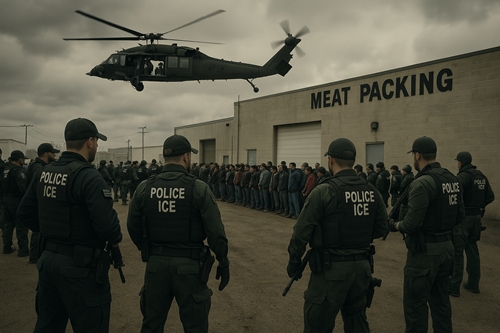Part 2 – When They Were Taken
The shriek of tires. The clash of doors. The sound of lives shattering.
It doesn’t always happen in the shadows. Sometimes it happens at school pickup. On the way home from work. While children draw sidewalk chalk hearts in the driveway.
That’s how it happened in Postville, Iowa. In 2008, armed agents swarmed a local meatpacking plant. Helicopters thundered overhead. Nearly 400 immigrants were arrested, most within hours. Some were longtime residents, others spoke little English and many had children enrolled in local schools. For days, the town felt like it had been hollowed out. “It was like someone pulled the soul out of Postville,” one pastor said.
In Morristown, Tennessee, a school cafeteria became a triage center of tears. ICE detained 97 workers during a raid on a meatpacking plant in 2018. That morning, dozens of children were left stranded. No parents came to pick them up. Teachers scrambled. Social workers fielded panicked calls. One fourth-grader wept quietly while drawing a picture of a van. It was the last place she’d seen her father.
In Los Angeles, a mother attending a routine immigration check-in was detained on the spot; no warning, no contact with her kids. Her four children waited in the car. Hours passed. They were eventually driven home by strangers.
And in New York, a father dropping his daughter at kindergarten was handcuffed in the parking lot. She watched from the classroom window as his car was towed away. For months, she drew him in every art project, always with a backpack, always reaching for her hand.
This is what enforcement often looks like; not just detentions, but ruptures.
Families ripped apart without explanation. Paperwork lost. Children left in limbo. Legal status questioned, then quietly erased. And like the black-clad raid outside the fictional M family’s home, many of these removals are sudden, militarized, and witnessed by neighbors who assumed such scenes only happened elsewhere.
But in the middle of this trauma, communities also rise.
In Iowa, churches defied federal pressure and sheltered mothers and children. In Tennessee, teachers turned classrooms into emotional safe zones. In California, neighbors launched legal funds and carpool systems for kids whose parents never came home. Some mayors stood up. Some city councils pushed back. One child’s drawing made the front page of a national newspaper. It read: “Don’t take my mom. She needs to see me grow.”
When the black cars leave, what remains is memory…and movement.
The story of the M family in Part 1 isn’t an isolated tragedy. It’s a pattern repeating across zip codes and years. It’s unfolding quietly behind front doors and brightly lit loading docks. But it’s also waking people up. Turning neighbors into advocates. Classmates into voices for change. Ordinary towns and cities into sanctuaries.
Because when families are disappeared in plain sight, the true test isn’t how shocked we are.
It’s whether we stay silent.
What would your town do if dozens of parents were taken in a single morning? If a classmate simply didn’t come back? Don’t wait until it happens. Build the structures now. Speak the names. Make your neighborhood somewhere people are protected, not disappeared.
Coming Next: “They Were at My Graduation Last Year”
What happens to a school when students vanish overnight? When PTA moms don’t come back, when teachers hesitate to call roll, when kids grow quiet because they don’t know if their friends are okay? In Part 3, we step into the hallways and classrooms that bear the invisible weight of immigration enforcement—and meet the educators, classmates, and parents trying to carry it together.
Resources for Immigrant Support: Legal Aid, Community Services, and Where to Give
